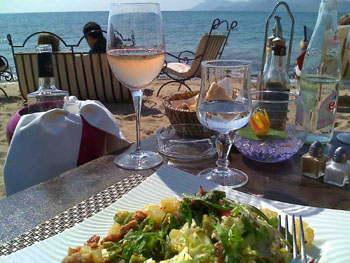 Find
more articles about the South of France Here
Find
more articles about the South of France Here
Interesting places to see and visit in the South of France + Monaco
(Listed
in Alphabetical order)
See also Riviera realty from French Property News September 2006
and Nice Fact File
and South of France Fact File
Above: View of Port de Marina Baie des Anges and Biot from the air - Click on image to enlarge
(Listed
in Alphabetical order)
Aigues-Mortes:
This is seemingly untouched since it was built by Louis IX
in the 13th Century. The walled town is a perfect
example of a medieval village. Even its ramparts are completely
intact. From the walls there are fabulous views down into
the village itself and for miles across the flat marshy landscape
all around. The Constance Tower – once a prominent look out
post and the Governor’s house are also worth seeing.
Aix-en-Provence:
It is described as the
“ Town of water, town of
art... it was built and has developed around this dual identity.
It was a Celtic-Ligurian capital from the 3rd century BC was
pushed aside for the founding of Aix in 122 BC. The
Cours Mirabeau is
the centre of the town
and the heart of Aix. It is a beautiful tree lined
avenue,with one side lined with wonderful terrace cafés and
bookshops.
 Alpha
- Le Boréon -near St Martin Vésubie. In 1992 the wolves
came back to France. A half hour drive up into the Alps from
Nice. Mercantour National Park that is close to the Italian
border in the Alpes Maritime the park covers over 685 km2
of stunningly beautiful mountain countryside. Ideal for walking,
hiking and exploring. More infomrantion at their website
les Tempsdu loup
Alpha
- Le Boréon -near St Martin Vésubie. In 1992 the wolves
came back to France. A half hour drive up into the Alps from
Nice. Mercantour National Park that is close to the Italian
border in the Alpes Maritime the park covers over 685 km2
of stunningly beautiful mountain countryside. Ideal for walking,
hiking and exploring. More infomrantion at their website
les Tempsdu loup
Alpilles: The
Alpilles are a dramatic chain of mountains that rise up out
of the Rhône
and the Durance. There are some well worn walking trails that
run through the region with red and white markers denoting
the Grande Randonnee (GR) trails throughout France. The route
along Crêtes or mountain ridge above the village of Saint-Rémy
is particularly worthwhile taking. Alternatively you can discover
the region on horseback.
 Antibes: This
lively town which lies at the opposite end of the Baie des
Anges (Nice) is one of the most sought after spots on the
coast.It is home to
Antibes: This
lively town which lies at the opposite end of the Baie des
Anges (Nice) is one of the most sought after spots on the
coast.It is home to  Port
Vaubaun -
the largest marina on the coast. You will normally find a
large selection of yachts from the small 4 berth to the 4-5
deck plus complete with helicopter. The town has a picturesque
walled old town and in the centre of the old town close to
the market is Chateau Grimaldi the home of the Picasso museum
that overlooks the sea. There are some lovely sandy beaches,
including the Plage de la Salis that is open to the public.
In neighbouring Juan les Pins for example many of the stretches
of beach are only for the use of hotels and restaurants (although
you can walk along the sun in front of them).
Port
Vaubaun -
the largest marina on the coast. You will normally find a
large selection of yachts from the small 4 berth to the 4-5
deck plus complete with helicopter. The town has a picturesque
walled old town and in the centre of the old town close to
the market is Chateau Grimaldi the home of the Picasso museum
that overlooks the sea. There are some lovely sandy beaches,
including the Plage de la Salis that is open to the public.
In neighbouring Juan les Pins for example many of the stretches
of beach are only for the use of hotels and restaurants (although
you can walk along the sun in front of them).
(see also Cap d'Antibes below)
Antibes
a magical town in the south of France to visit again and again
Here
Arles:
Arles was first a Celtic dwelling-place, then a Greek colony,
before Julius Caesar settled the veterans of his Roman legions
here in 46 BC. Arles
is has varied landscapes. It is the gateway to the Camargue,
one of the nicest natural sites in Europe with an exceptionally
rich animal life. The Alpilles (see above), dominated by the
town of Les Baux-de-Provence, stretch 25 kilometers to the
Northeast. These limestone hills are surrounded by sunny pleasant
Provençal villages spread out among vineyards and olive orchard.
On the border between Provence and Languedoc, your stay in
Arles will bring you close to Beaucaire and Tarascon, Les
Saintes-Maries de la Mer, Nîmes and the Pont-du-Gard, Avignon
and the Papal Palace, Aix-en-Provence and the Montagne Sainte-Victoire,
Marseille.
 Avignon:
is a city
of full of history and city of theatre, Located
at the confluence of the Rhône and Durance rivers, Avignon
is well known for its ramparts, its famous Pont Saint-Bénezet
and the Palais des Papes. (Popes palace)
It
is a fortified
city that is marked by papal history. The walls of the city
have seven doors that are superbly preserved and you can then
discover the city of the Popes. The Palais
des Papes built in the 14th century
overlooks a lively square. Nearby are the museums the Petit
Palais and Palais du Roure and not too far away is the famous
Pont Saint-Bénezet
Avignon:
is a city
of full of history and city of theatre, Located
at the confluence of the Rhône and Durance rivers, Avignon
is well known for its ramparts, its famous Pont Saint-Bénezet
and the Palais des Papes. (Popes palace)
It
is a fortified
city that is marked by papal history. The walls of the city
have seven doors that are superbly preserved and you can then
discover the city of the Popes. The Palais
des Papes built in the 14th century
overlooks a lively square. Nearby are the museums the Petit
Palais and Palais du Roure and not too far away is the famous
Pont Saint-Bénezet
Baie
des Anges: This vast bay stretches from the Cap d’Antibes
westwards as far as Cap Ferrat in the east with Antibes at
one end and Nice at the other.
If you fly to Nice you will normally approach the airport
via the Baie des Anges and from the Antibes direction pass
over the semi circular development of apartments at Villeneuve
Loubet. Another good vantage point to view the baie is the
château in Nice.
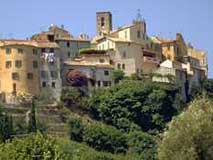 Biot:
is located 5 kms inland; it is built
on a headland that is typical of this type of hill top village
(Mougins, St Paul de Vence, Cagnes old town etc) and overlooks
the sea. It is one of the art centres of the south of France.
Apart from its beautiful location, a major reason to visit
Biot is for the potteries and glassworks (Verreries) and the Léger Museum. The artist Fernand Léger made the village his home
and both it and its people had a profound effect on his work.
Unlike some of the neighbouring hill top villages, Biot has
not been spoilt by too many art shops, estate agents and expensive
restaurants. It still retains much of its cobbled streets.
Biot:
is located 5 kms inland; it is built
on a headland that is typical of this type of hill top village
(Mougins, St Paul de Vence, Cagnes old town etc) and overlooks
the sea. It is one of the art centres of the south of France.
Apart from its beautiful location, a major reason to visit
Biot is for the potteries and glassworks (Verreries) and the Léger Museum. The artist Fernand Léger made the village his home
and both it and its people had a profound effect on his work.
Unlike some of the neighbouring hill top villages, Biot has
not been spoilt by too many art shops, estate agents and expensive
restaurants. It still retains much of its cobbled streets.
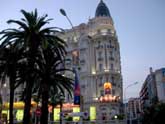 Cannes: It
is described
by some as one of the classiest resorts on the Cote d’Azur,
although very expensive and having one of the longest shopping
streets in Europe, you can still find a reasonably priced
hotel and meals locally. It is has a picturesque old town
overlooking the town and is famous for its annual film festival
held in May each year. It has wonderful sandy beaches that
are accessible from the main promenade “La Croisette”. There
is also a working fishing port contrasted by private moorings
from some the most expensive yachts in the world.
Cannes: It
is described
by some as one of the classiest resorts on the Cote d’Azur,
although very expensive and having one of the longest shopping
streets in Europe, you can still find a reasonably priced
hotel and meals locally. It is has a picturesque old town
overlooking the town and is famous for its annual film festival
held in May each year. It has wonderful sandy beaches that
are accessible from the main promenade “La Croisette”. There
is also a working fishing port contrasted by private moorings
from some the most expensive yachts in the world.
Cavaillon:
The town of Cavaillon is normally
associated with Charentais melons that are a major crop. It
lays claim to one of the few remaining triumphal arches of
Roman France. The arch is still in remarkable condition and
with some exquisite carvings it was moved during the 19th
century from its original location and is now on the edge
of the square where the weekly fruit and vegetable market
is held.
Camargue:
The flat marshy land of the
Camargue is renowned for its bird life, particularly the pink
flamingos. The main centre is the village of Les Saintes Maries
de la Mer, from where boat trips leave several times a day
during summer. You can also consider taking a four wheel drive
safari.
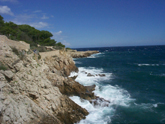 Cap
d’Antibes: It
was renowned as the party capital of the Riviera in the 1920’s.
The Hôtel
du Cap Eden Roc
was one of the first to open for the summer season. The area
was soon popular with rich Americans, including Scott and
Zelda Fitgerald, Ernest Hemingway and Rudolph Valentino. Later
on other famous names made their homes in the area – Graham
Greene and Pablo Picasso. Today the Cap still retains its
elegance and you can take some interesting walks along the
coast. There is 24.5km of coastline and has five harbours.
One of these is Port Vauban situated overlooked by Antibes
vielle ville. This is one of the largest in Europe and you
can see boats that range from small pleasure boats to yachts
that are big enough to have their own helicopters on one of
the decks! Overlooking
the Port from the Baie des Anges side is Fort Carré.
Cap
d’Antibes: It
was renowned as the party capital of the Riviera in the 1920’s.
The Hôtel
du Cap Eden Roc
was one of the first to open for the summer season. The area
was soon popular with rich Americans, including Scott and
Zelda Fitgerald, Ernest Hemingway and Rudolph Valentino. Later
on other famous names made their homes in the area – Graham
Greene and Pablo Picasso. Today the Cap still retains its
elegance and you can take some interesting walks along the
coast. There is 24.5km of coastline and has five harbours.
One of these is Port Vauban situated overlooked by Antibes
vielle ville. This is one of the largest in Europe and you
can see boats that range from small pleasure boats to yachts
that are big enough to have their own helicopters on one of
the decks! Overlooking
the Port from the Baie des Anges side is Fort Carré.
Cassis:
This
is a charming resort that has a picturesque harbour. Sir Winston
Churchill used to paint there when he was taking holidays
in the area.You can also take boat trips from there.
Châteauneuf-du-Pape:
This
is one of the best known names in the wine world. Châteauneuf
was where the Avignon Popes had their summer residence. There
are dozens of wine producers in the village who are all keen
to explain how they make their wines and then how their wine
is better than their competitor’s! There are plenty of opportunities
to taste without having to buy.
Eze:
There
is Eze sur Mer and perched up on the hill behind it is Eze
village. Some say that it is one of the most perfect spots
on the Cote d’Azur with spectacular views over the Mediterranean
coast with the Alps as a backdrop.
Fréjus:
Julius
Caesar founded this town. It was once important port and was
larger under the Romans than it is today. Sections of the
old city walls are still visible, as are parts of an aqueduct;
a theatre, amphitheatre, and various other buildings that
are all now intermingled with the remains of the medieval
city that took over where the Romans left off.
Gordes:
This
village is perched on a hilltop above the Luberon National
Park (see Luberon National Park below). This is one of the
most beautiful villages in the whole of France. The views
of Gordes from the approach road are breathtaking. In the
village itself, there are steep cobbled streets that meander
up and down around a château built in the 11th
century. This is the focal point of the village. You can relax
for a while in one of the many shaded cafés in the Place du
Marché.
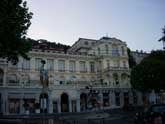 Grasse: Although
it has expanded in modern times, it has managed to hold on
to its village atmosphere. It is very famous as being the
centre of the French perfume industry and many of the perfumeries
are open to visitors. Before it was famous for perfume it
was very well known for its tanneries. Today there are over
30 perfumeries.
Grasse: Although
it has expanded in modern times, it has managed to hold on
to its village atmosphere. It is very famous as being the
centre of the French perfume industry and many of the perfumeries
are open to visitors. Before it was famous for perfume it
was very well known for its tanneries. Today there are over
30 perfumeries.
Three of these famous perfumeries welcome visitors. Fragonard that was established in 1926 and housed in the historic factory at Boulevard Fragonard. Gal There Grasse is surrounded by acres of scented flowers. Galimard - in 1747 Jean de Galimard, Lord of Seranin established Galimard. In earlier times the manufacturer supplied King Louis and his court. They are located at Route de Cannes and Route de Pegomas. Molinard - The house of Molinard was established in 1849. It is located at Boulevard Victor Hugo. You can normally purchase perfumes at factory prices at the end of a tour.
There is a daily flower market in the Place aux Aires. Grasse
hosts an annual international rose exhibition each May and
there is the La Jasminade flower fête each August. The old
medieval village is a comfortable mixture of narrow cobbled
streets climbing up and down and elegant merchant homes. A
great deal of money is being spent on the town by local government.
The
town’s Romanesque Cathédrale Notre-Dame-du-Puy was built in
the 12th century to replace a 200 year old fortress.
Part of the original tower still remains. The south side of
the cathedral houses many works of art including several by
Fragonard and Rubens. Fragonard was the son of a Grassois
perfumed glove maker. His painting can be seen in the Villa-Musée
Fragonard.
Gréolières-les-Neiges: Altitude
: 1400-1800 m. It is one of the closest ski resorts to the
coast. It is 27 km from Grasse - 38 km from Cannes - 57 km
from Draguignan. A
small ski resort, great for families
and as it so close to the coast great for day trips for
skiing.
Hyères:
This
is the oldest resort on the coast that has been popular since
the late 19th century when many wealthy British
people came to the town to spend the winter. As a result the
town has many elegant villas that are surrounded by delightful
gardens. The beaches are located on the eastern side of the
peninsula south of the town and three beautiful islands are
accessible from the port.
Iles
de Lérins: The
beaches on the two Lérins islands Sainte Marguerite and Saint
Honorat are the least crowded on the French Riviera because
a lot of people are deterred
by the 15 minute boat trip from Cannes. Both the islands
are covered with eucalyptus and pine trees and offer lovely
unspoilt beaches to explore. It is easy to walk around the
islands.
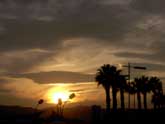 Juan- les- Pins is
fashionable with younger crowds as well as families. It has
a number of private beaches, and many bars and restaurants,
plus market stalls along the promenade in the evening. The
respected Jazz à
Juan festival is held each summer in the Pinede (pine
grove).With its hectic nightlife it's hard to believe Juan-Ies-Pins
used to be a tranquil spot of pine trees and sandy beaches
until its conversion to tourism in the 1920s and 30s.
Juan- les- Pins is
fashionable with younger crowds as well as families. It has
a number of private beaches, and many bars and restaurants,
plus market stalls along the promenade in the evening. The
respected Jazz à
Juan festival is held each summer in the Pinede (pine
grove).With its hectic nightlife it's hard to believe Juan-Ies-Pins
used to be a tranquil spot of pine trees and sandy beaches
until its conversion to tourism in the 1920s and 30s.
Les
Baux De Provence: Les
Baux looks like a large rock from the east side. Go around
to the other side and you will discover that the village has
been literally carved out of it. Originally there was just
a castle that played an important role in the turbulent history
of medieval Provence. The rest of the village was added several
centuries later. Why not spend a night there so that you can
wander during the evening and avoiding the day trippers.
Nestling
just below Les Baux and with spectacular views of the castle
is the L’Oustau de Baumaniere. The views of the castle are
even better when it is illuminated at night. It is a quite
spot off the tourist track, but it is a central base for exploring
the Alpilles region. The gardens are planted with roses and
scented plants and there are plenty of places to sit, eat
and drink in the open air.
Luberon
National Park: This
was made popular for British tourists in Peter Mayle’s book
“A year in Provence”, it is well worth a visit. It has spectacular
scenery and dramatic hill villages. An ideal way to get around
is on bike. They can be rented locally in towns such as Apt.
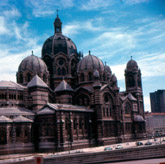 Marseille: Is
part of the region
of Provence, Marseilles was founded in 600 b.c. by the Greek
sailors of Phocaea. It city is the oldest in France and second
largest city in France and the largest commercial port, Marseilles.
When France was a colonial power it was the gateway to the
Mediterranean, Today Marseilles remains a capital of southern
Europe, cosmopolitan and exuberant, with its picturesque old
port, its Bouillabaisse and its folklore.
Marseille: Is
part of the region
of Provence, Marseilles was founded in 600 b.c. by the Greek
sailors of Phocaea. It city is the oldest in France and second
largest city in France and the largest commercial port, Marseilles.
When France was a colonial power it was the gateway to the
Mediterranean, Today Marseilles remains a capital of southern
Europe, cosmopolitan and exuberant, with its picturesque old
port, its Bouillabaisse and its folklore.
The
old port has lots of charm and plenty of good restaurants.
The speciality is bouillabaisse made from a selection of local
fish and seafood. There are restaurants all along the three
quaysides that enclose the harbour. The most popular with
locals is Le Mets de Provence.
 Menton: Is the warmest resort on the French Mediterranean
coast. It is therefore also a good place to visit out of season.
It is less pretentious than a lot of other resorts. It seems
to have been almost overlooked by tourists. The local government
has spent a great deal of money on it over the past few years
and it is very attractive. The old town buildings clinging
to the hillside, that dips steeply into the sea. It is a border
town and although feels very French, it also has a very Italian
flavour to it as well.
Menton: Is the warmest resort on the French Mediterranean
coast. It is therefore also a good place to visit out of season.
It is less pretentious than a lot of other resorts. It seems
to have been almost overlooked by tourists. The local government
has spent a great deal of money on it over the past few years
and it is very attractive. The old town buildings clinging
to the hillside, that dips steeply into the sea. It is a border
town and although feels very French, it also has a very Italian
flavour to it as well.  Left: Harbour at Menton
Left: Harbour at Menton
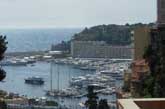 Monaco:
Located on the Mediterranean Sea, tucked into the Maritimes
Alps, it is only
minutes from Nice International Airport ( bus, train and helicopter
connections) and the French and Italian Rivieras. It has a population of 32,020
and is 2 sq km
in size. The currency is the euro as in the neighbouring countries.
Most of the people who dwell here come from somewhere else,
drawn by the sun, glamourous lifestyle and – most importantly
– tax-free income and more police per head of population than
in any other European country.
Monaco:
Located on the Mediterranean Sea, tucked into the Maritimes
Alps, it is only
minutes from Nice International Airport ( bus, train and helicopter
connections) and the French and Italian Rivieras. It has a population of 32,020
and is 2 sq km
in size. The currency is the euro as in the neighbouring countries.
Most of the people who dwell here come from somewhere else,
drawn by the sun, glamourous lifestyle and – most importantly
– tax-free income and more police per head of population than
in any other European country.
Monaco's
history is pretty much the history of the Grimaldi family
who have ruled the principality for over 700 years. - A 1918
treaty with France states that, should the Grimaldis die out,
Monaco will become an autonomous state of France. In -2002
Laws were passed in the same year to ensure that the Grimaldi
family would remain in power even if Prince Albert did not
have an heir to the throne. There are a number of annual events
held including the Formula 1 Grand Prix in May (and every
other year the Historic Grand Prix) and International Open
Tennis Championships in April, Monte Carlo car Rally in January
and the Monte Carlo Television Festival in February.
The
famous casino can be found in Casino Square at Monte Carlo.
See Also Historic
Monaco Grand Prix - Grand Prix de Monaco Hisorique
Montpellier:
is in the heart of the Laguedoc region. It is 7km from
the sea and has the benefit of its own airport. The centre
of the town is the Place de la Comédie which is surrounded
by buildings including the opera house. There is an old town
that is mostly pedestrianised has picturesque squares and
courtyards. There are plenty of shops along the Grande Rue
Jean Moulin. There is always something on there – music, dance
and art festivals,
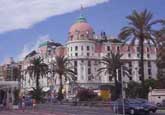 Nice: Putting
the mild climate and diverse landscapes aside, Nice is more
than just a seaside resort. It is one of the most stylish
cities in France. Apart from the beach that extends for miles,
there are plenty of shops, a Russian cathedral, an old quarter
with a lively market and a couple of worthwhile museums. One
of these is dedicated to Chagall and the other to Matissse.
They both worked and lived in the region.
Nice: Putting
the mild climate and diverse landscapes aside, Nice is more
than just a seaside resort. It is one of the most stylish
cities in France. Apart from the beach that extends for miles,
there are plenty of shops, a Russian cathedral, an old quarter
with a lively market and a couple of worthwhile museums. One
of these is dedicated to Chagall and the other to Matissse.
They both worked and lived in the region.
The
city of Nice
extends inland with its pedestrian area featuring luxury boutiques,
Massena gardens with their fountains and the picturesque old
town. Nice stretches the length of the Baie des Anges, lighting
up the whole of the Riviera with its majesty. When you fly
into Nice airport the views are superb by day or night.
It
is a magnificent city, the epitome of Riviera charm, a gentle
way of life and luxury that has an exceptionally mild and
sunny climate, blue sea and azure skies. Nice is a thriving
tourist city, sought after all year round by lovers of the
French Riviera. The Promenade des Anglais is a world-famous
attraction, which is the pride of the city of Nice.
Nice
offers everything you could wish for in a holiday destination
- history, spectacular scenery, architecture and a buzzing
nightlife, not forgetting plenty of sun and sea.
Located
half way along the Promenade des Anglais is famous Negresco
hotel. It has become a landmark in its own right. Henri Negresco
was a director of the casino and he built the hotel with the
sole intention of attracting its wealthiest clients who would
appreciate the palatial surroundings that are still a major
feature. Guests have the use of a private beach.
Well worth a visit is the Old Town that dates back to medieval times or La colline du chateau dating back to the eleventh century. The old town contains within its narrow alleyways, the expanses of its squares and the Cours Saleya over 250 restaurants, 200 boutiques and galleries. Other excellent places for sightseeing include the Basilique Notre-Dame - the largest church in Nice, built in 1864. Other sightseeing hotspots include La Cathedrale Saint-Reparate, built in the seventeenth century, and the 16th century L'Ancien Hotel de Ville, formerly Nice's town hall. Climb (or take the lift) up to the castle and enjoy panoramic views over the Baie des Anges and visit the two cemeteries lying side by side the Christian and neighbouring Jewish cemetery. SEE: Nice port under restoration - October 2010
Nimes:
There may be 19 amphitheatres in
the Roman world that are larger than the Arena at Nimes. It
is the best preserved. It was originally used for gladiators
or animal combat. Later it became a military fortress and
then in medieval times houses were added that turned it into
a small town. The modern removable covering allows the amphitheatre
to be used all year round for performances. Nimes was once
a Roman staging post between Spain and Italy. Although full
of it’s heritage it is also a real living city. The famous
Pont du Gard a tripple decker Roman aqueduct built to bring
drinking water to Nimes is well worth seeing. It was built
just before the birth of Christ. There are some pleasant walks
along the river and you can also walk across the aqueduct
as well. Rental
France
Orange:
was the former seat of the counts of Orange Today the
town is best known for its spectacular
Roman theatre that is the best preserved in Europe.
Much of the back wall of the stage is still intact. In a series
of pillars and niches containing the statues of imperial benefactors,
a statue of the Emperor Augustus nearly 4 metres high has
been reconstructed from fragments found around the theatre
and replaced in its domed niche in the centre of the wall.
the Arc de Triomphe,
whose intricate frieze and relief celebrates imperial victories
against the Gauls. It was built around 20 BC outside the town
walls to recall the victories of the Roman Second Legion.
Port
Grimaud
was designed in 1966 by the French architect Francois Spoerry.
It was the dream of an architect and sailor as well, having
his own boat just in front of the house. It is the most significant
construction of its style in the whole Mediterranean.
All units in Port Grimaud, except smaller apartments,
have their own mooring Port Grimaud is an excellent marina
across the bay of Saint-Tropez,
protected from Wind form the East and the ”Mistral” from the
West.
Roussillon:
The unique feature of this hilltop village are the ochre
colours of the landscape. The shades of earth range from deep
red to pale yellow and are visible in the hillsides and rock
outcrops resulting in a wonderful contrast against the greens
of the foliage. A well defined walking trail that takes approximately
half an hour leads you past the most dramatic colour combinations.
 St Tropez: This was
once the home of painters and artists who valued the fact
that it was the most inaccessible village on the coast. St
Tropez suddenly saw a tourism boom that brought it to life
after Brigitte Bardot came there in the 1950’s to film “And
God created Woman” Many other famous people have lived there
including Eddie Barclay and Dirk
Bogarde It is quite difficult to get into the village
in the height of the season, with long queues, but despite
that once you are in there it still has that unhurried Provencal
atmosphere. The best beaches will be found a few kilometres
out of the town to the southeast.
St Tropez: This was
once the home of painters and artists who valued the fact
that it was the most inaccessible village on the coast. St
Tropez suddenly saw a tourism boom that brought it to life
after Brigitte Bardot came there in the 1950’s to film “And
God created Woman” Many other famous people have lived there
including Eddie Barclay and Dirk
Bogarde It is quite difficult to get into the village
in the height of the season, with long queues, but despite
that once you are in there it still has that unhurried Provencal
atmosphere. The best beaches will be found a few kilometres
out of the town to the southeast.
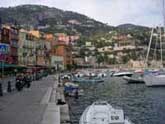 Villefranche-sur-Mer: Located
on the east side of Nice, just five kilometres away,
this picturesque village has not lost any of
it’s character over the last 30 years.It is one of the most
spectacular sections of the Riviera.It is built on wooded
slopes around a picturesque fishing harbour and small port
. There are restaurants facing the port. The old town that
climbs up the hill with the church in the centre has narrow
lanes and tall brightly coloured houses, some of which have
"tunnels" between them.There is a good stretch of
sandy and shingle beach beach and every Sunday there is a
flea market offering a good selection of bric a brac. There
is even a special dog toilet. Cruise liners often stay overnight
in the the deeper waters and their passengers are ferried
into the town for sight seeing.
Villefranche-sur-Mer: Located
on the east side of Nice, just five kilometres away,
this picturesque village has not lost any of
it’s character over the last 30 years.It is one of the most
spectacular sections of the Riviera.It is built on wooded
slopes around a picturesque fishing harbour and small port
. There are restaurants facing the port. The old town that
climbs up the hill with the church in the centre has narrow
lanes and tall brightly coloured houses, some of which have
"tunnels" between them.There is a good stretch of
sandy and shingle beach beach and every Sunday there is a
flea market offering a good selection of bric a brac. There
is even a special dog toilet. Cruise liners often stay overnight
in the the deeper waters and their passengers are ferried
into the town for sight seeing.
Villeneuve-Loubet: The village is 3km from the sea.It stands on a hill, while the new town and its buildings stretch down to the Mediterranenan. The village was built in the XIII?th century at the foot of the castle of Romée de Villeneuve, who gave it his name. In this current configuration, the village dates from the beginnings of the XVI?th century. Villeneuve-Loubet offers its visitors 4 kms of coast-line with high-quality water for bathing. There are both public or private beaches, so there is something for everyone. The natural beaches are made of round pebbles from the river Loup that have been polished by the sea, Marina Baie des Anges is a development of apartments with a marina in front with 527 berths which can accommodate craft up to 30 metres long.If you ar approsching Nice airport by air you can often get spectacular views of this development a moment or two after seeing Antibes old town (at top of this page). Villeneuve-Loubet is the birthplace of the famous 19th century provençal chef, restaurateur, and culinary writer Auguste Escoffier, the author of the Guide Culinaire and the founder of French haute cuisine.
©jmlpropertyservices05/05
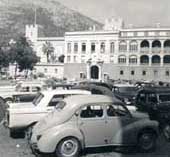
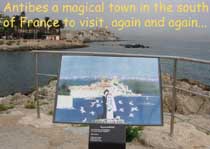 Antibes
a magical town in the south of France to visit again and again
Antibes
a magical town in the south of France to visit again and again
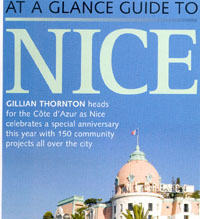 At
a Glance Guide to Nice - Destination France - Spring 2010
At
a Glance Guide to Nice - Destination France - Spring 2010
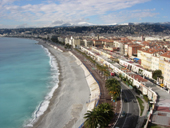 Nice
and the South of France in January
Nice
and the South of France in January
Nice Fact File Click Here
South of France Fact File Click Here
Riviera realty from French Property News September 2006 Click Here
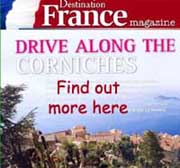 Drive
along the corniches of the Riviera - Destination France -
Spring 2012
Drive
along the corniches of the Riviera - Destination France -
Spring 2012
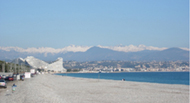
_________________________________________________
X XXEnjoy your stay in the South of France ....
eat - drink -stay & wake up on the Riviera
________________________________________________
See site Map for statutory information about jml Property Services Here










